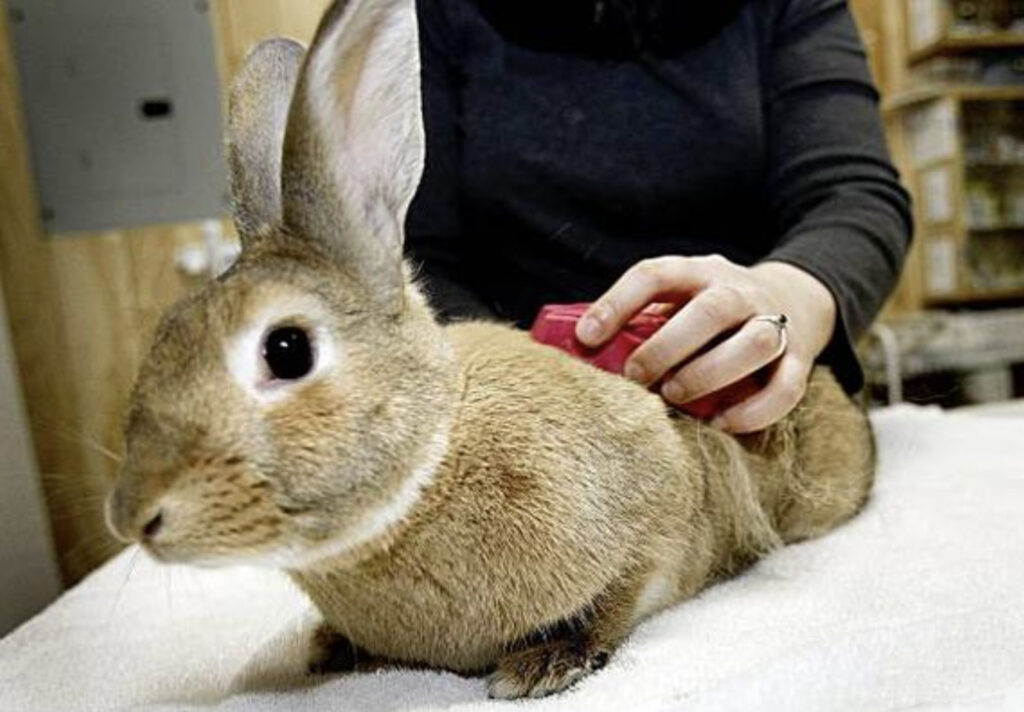Rabbits can act as if they’re hardy creatures, but they are, in fact, extremely delicate-from their skin to their spines to their external systems. Care must be taken to maintain their good health. The following basics are necessary to know in order to groom rabbits safely and to help keep them healthy. For information specifically geared towards the caring for long-haired rabbits, see the reprint of the House Rabbit Journal article, “The Well-Groomed Rabbit.”
Shedding
Rabbits shed every three months. Every alternate time they’ll have a light shedding that may not be very noticeable. Next they’ll have a heavy shedding that you will not be able to escape.
Rabbits are fastidious groomers. They insist on being clean and tidy and will lick themselves like cats, and like cats, they can get hairballs if they ingest too much hair. Unlike cats however, rabbits cannot vomit. If hairballs are allowed to form they can become gigantic masses of tangled hair and food and will block the stomach exit, causing the rabbit to starve to death while his stomach appears to be very fat.
Rabbits need to be brushed at least weekly. In addition to removing any loose hair, this weekly brushing session helps prepare them for the multiple daily brushings that they must undergo when their heavy shedding begins. Rabbits will shed in different ways. Some rabbits will take a couple of weeks or more to loose their old coat of fur. Other rabbits will be ready to get rid of their old coats all in one day and these rabbits are the ones that cannot be neglected once they start shedding. You can often remove a very large percentage of hair by just pulling it out with your hand. But, however you remove it, remove it as soon as possible or your rabbit will do it during grooming.
Bald spots on rabbits are quite common when they are shedding. I have one Angora rabbit for instance, that gets totally naked except for her face and feet. But, short haired rabbits can do the same thing. If these bald spots occur from shedding, they will begin to grow back within a week or two.
Long-Haired Rabbits
These types of rabbits are truly wonderful to look at, but require a lot more attention than their short haired cousins. We recommend that you use your scissors and keep their hair trimmed to one inch or less, otherwise you may be fighting hairballs most of the time.
EXPERT HELP: If you are not comfortable with the above you can have someone, maybe your veterinarian, show you how to do all of the above tasks.
Fleas and Mites
Safe treatments to prevent and kill fleas on rabbits include Advantage (imidocloprid), Program (lufenuron) and Revolution (selamectin). (Note: Advantage has been known, rarely, to irritate the skin of certain rabbits.) The latter is preferred, as it is also effective against various types of mites that cause symptoms of mange, ear canker, and “dandruff” (which is often caused by fur mites in the genus Cheyletiella). These products are available from your rabbit-savvy veterinarian. We use 0.4ml per rabbit of Advantage. For Revolution, we use the kitten dose and apply it between the shoulder blades once a month for at least three doses. Revolution is usually dosed at 6mg/kg. If you have the 60mg/ml solution (i.e. the kitten solution), use 0.1cc per kg of body weight (1kg = 2.2lb). If you have the 120mg/ml solution, use 0.05cc per kg of body weight. You’ll need a tuberculin syryinge (no needle!) from your vet to measure such a small quantity of liquid. Apply to the back of the neck or other area where the bunny can’t readily groom it off. It is essential to thoroughly clean your rabbit’s cage and exercise areas after each treatment to control reinfestation, since fur and dander in the environment may contain mite eggs.
A flea comb is a non-toxic device that takes more patience, but is both physically and psychologically rewarding. Most rabbits learn to love the attention of being flea combed, and it can be used as a supplement to your main flea-control program.
The following products should NOT be used on rabbits:
- Frontline (fipronil) has been linked to neurological damage and death in rabbits, although this product is apparently safe for dogs and cats. The manufacturer (Merial) has placed a warning on the Frontline label stating that Frontline should never be used on rabbits.
- Flea powders, even those considered safe for cats and kittens or advertised as “rabbit safe”, are not recommended for use on rabbits.
- Flea shampoos, even those considered safe for cats and kittens or advertised as “rabbit safe”, are not recommended for use on rabbits. Bathing of rabbits, in general, is strongly discouraged because the stress of the bath itself can cause serious health problems, and has in some cases been linked to the death of the rabbit. Flea baths or dips are NOT recommended for this reason.
- For environmental flea control, sprays and “bombs” are not recommended, as they may leave harmful residue that the rabbit can ingest. Safer alternatives include borax and diatomaceous earth, worked into the carpet where fleas leave their eggs.
Baths
Although a rare bunny may grow up swimming in the family pool and going on camping trips where she paddles around in the lake, the vast majority of rabbits, like their ancestors, do not relish getting wet. Even an occasional bath is quite stressful to the average rabbit, and is not recommended.
NEVER–unless your veterinarian advises it to bring down a fever–should you give a sick rabbit a bath. Because seemingly healthy rabbits can have undiagnosed problems, it’s best not to subject them to the stress of a bath. If your rabbit is very badly infested with fleas, there’s a good chance that he is already compromised and may go into shock when bathed. There are many safe alternatives to flea control (see these under “Fleas,” above). Also, a thoroughly wet rabbit takes a very long time to dry, so spot cleaning the dirty area with an application of baby cornstarch (available at any supermarket in the baby section) (do not use talcum, as it is carcinogenic) and then gently combing out the dirt with a fine flea comb is better than a wet bath.
A wet rabbit can quickly become hypothermic. If your rabbit is wet to the skin for any reason, be sure to thoroughly blow dry the bunny until even the undercoat is dry and fluffy. Normal rabbit body temperature ranges from 101oF – 103oF. Because rabbit skin is very delicate, and rabbits are sensitive to heat, never use a blow dryer on a setting higher than “warm,” and constantly monitor the temperature of the air on the bunny’s skin by placing your hand in its path.
Mats
Rabbit skin is delicate and highly susceptible to cuts, so mats should not be cut off with scissors. Instead, use a mat splitter or mat rake to take the mass apart. Bunny fur usually requires a finer blade than most cats and dogs.
Skin
Scratchy, flaky skin with bald patches is usually a symptom of mites or, more rarely, an allergic reaction to fleas. Products described under “Fleas” will usually clear up such problems. A veterinarian should be consulted for such conditions as open sores, or chronic skin inflammation.
Scent Glands
Rabbits have scent glands both under their chin (that’s what they use to mark items (and people!) when they chin things), and around their anus. When the anus scent glands build up, the rabbit often has an unpleasant odor. It’s simple to clean the glands, however. Simply dip a Q-tip into some warm water and hold your rabbit in a safe hold that gives you access to the genitals. Locate the two slits on either side of the rabbit’s genitals. Take the Q-tip and carefully swab away the brown buildup. It should just take you a second and you’re done!
Feet
House rabbits who spend all of their time in homes with carpeting and linoleum periodically need to have their toenails trimmed, in the same way as dogs and cats.
Because of risk of infection, declawing is definitely NOT recommended for rabbits.
If excessive digging or scratching is a problem, then a large box of hay or straw, where bunny can pursue these activities, may help.
If the padding (fur) on the feet is worn down, exposing inflamed or callused skin, then soft dry resting pads (rugs) should be provided. Exposed skin that becomes urine burned or broken is very likely to infect. Take extra care that rugs and litterboxes are kept clean and dry.
Incontinence
A rabbit with a urinary infection or a disabled older rabbit may not be able to project urine away from the body. The result may be saturated fur around the hindquarters. For milder cases, shave the areas that get wet so the skin can dry (remember, rabbit fur takes a long time to dry), rinse the affected areas daily, and follow up with a dusting of baby powder or corn starch. For more infirm cases, disposable baby diapers-turned backwards so the tabs are up-do wonders for keeping the moisture away from the skin. (Huggies Step 2 work well for an 8 pound rabbit.)
Ears
Ear wax can be lifted out with a cotton swab, being careful not to push on wax in the canal, or you can try a mild ear cleaner containing Chlorhexadine, such as Nolvasan Otic. For ear mite infestation, apply a topical medication such as Mitox. The veterinarian may also prescribe Ivermectin.
Teeth
Rabbits teeth grow continuously and must be checked to ensure that they are wearing down properly.While you’re brushing your rabbit or clipping his nails also look at his teeth to make sure there is not a problem.
Bunnies with straight teeth will keep them worn down with everyday gnawing and chewing. Buns with malocclusions, or crooked teeth, will need to have their teeth kept trimmed with guillotine-type clippers. If this occurs and is left untreated, the rabbit will not be able to eat and could starve to death. Your veterinarian can show you how to clip a rabbits teeth or they can clip them for you.
Nails
Rabbits nails can grow to be very long and sharp and will be uncomfortable for the rabbit. If the rabbit has light colored nails they are very easy to trim. You can see the blood inside the nail and you clip just before that point. The dark colored nails are harder to see where they should be clipped but it is still visible.
People are often afraid to clip nails for fear that they will cause the rabbit to bleed. You can purchase a product called Kwik Stop to keep on hand for this problem, but I’ve found that just holding pressure with a cotton ball works better for me. Your veterinarian will also clip nails for you. They should be checked every 6-8 weeks.
Eyes
Watery eyes or and eye discharge needs to be diagnosed by a vet. In addition to any medications or eye drops, the cheek needs to be kept dry and clean so the area will not become chafed nor the fur peel off. Clean tissues will absorb mild wetness. Ophthalmic saline solution (what people use with their contacts) carefully poured onto the cheek will crystallize the tears so that they can be removed with a clean flea comb. A touch of prescription anesthetic powder on a finger can be applied to the area if there are painful lesions.
Compiled with the assistance of Dr. Carolynn Harvey, DVM

